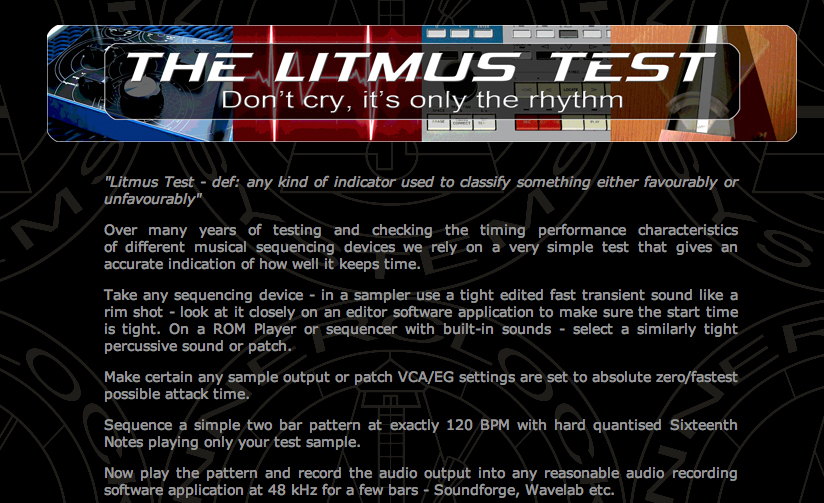Description © Innerclocksystems:
“Litmus Test – def: any kind of indicator used to classify something either favourably or unfavourably”.
Over many years of testing and checking the timing performance characteristics of different musical sequencing devices we rely on a very simple test that gives an accurate indication of how well it keeps time.
Take any sequencing device – in a sampler use a tight edited fast transient sound like a rim shot – look at it closely on an editor software application to make sure the start time is tight. On a ROM Player or sequencer with built-in sounds – select a similarly tight percussive sound or patch.
Make certain any sample output or patch VCA/EG settings are set to absolute zero/fastest possible attack time.
Sequence a simple two bar pattern at exactly 120 BPM with hard quantised Sixteenth Notes playing only your test sample.
Now play the pattern and record the audio output into any reasonable audio recording software application at 48 kHz for a few bars – Soundforge, Wavelab etc.”
Tested instruments:
– Roland: TR-606
– DSI: Tempest
– Akai: MPC-2500
– Akai: MPC-4000
– Analogic-ACS: TM-116 Analogue Control System
– Doepfer: Dark Time
– Korg: Monotribe
– TipTop Audio: Z-8000 Matrix Sequencer
– Akai: MPC-5000
– Kawai: R-100
– Analogue Solutions: Oberkorn MKIII
– Roland: MV-8800
– Roland: MC-909
– UREI: 964 Digital Metronome
– Akai: MPC-3000
– Akai: MPC-60 MK1
– Roland: MC-4B
– Roland: R-8MK1
– Elektron: Machine Drum SPS-1MKIIUW
– Roland: SH-101
– Linn: LinnDrum LM2
– Roland: CR-8000
– Roland: TR-808
– Roland: TR-909
Continue reading and check data by clicking the following link.

